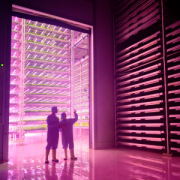Food systems are highly interlinked, from production to distribution to consumption, and there are significant social, cultural, economic, environmental, and political factors that interact with those processes. Understanding how vertical agriculture fits within these larger food systems is critical to advancing more sustainable food production. This Advisor presents three guiding principles for how vertical agriculture businesses can contribute to biodiversity conservation.
3 Guiding Principles
1. Diversification
The diversification principle is the what aspect of vertical agriculture. That is, what does the vertical farm produce? The principle is derived from a framework proposed by researchers Sarah Rotz and Evan D.G. Fraser. Their framework for social-ecological resilience in food systems suggests that food system resilience is achieved through diversity of components, connectivity between components, and decision-making autonomy within the food system.
Diversity is integral to resilient ecosystems and economic systems because it allows systems to continue to function in the event that a shock significantly impacts a species population or industry. In vertical agriculture, product diversification can contribute to economic resilience and enable access to more markets while increasing its ability to offset the impact of conventional agriculture.
Currently, vertically farmed products are primarily limited to leafy greens (see Figure 1), and without diversification, its land-sparing potential will be limited by a lack of ability to engage in this form of production for most crops. Businesses must invest in R&D to increase the types of products offered through vertical agriculture so it can play a significant role in food systems, rather than just being used for novelty products. Particularly important is understanding the local markets in which vertical farms exist so they can offer products that align with cultural food preferences and needs.
.jpg)
One example is Freight Farms, a Boston, Massachusetts, USA–based company that distributes grow systems for businesses, not-for-profits, and educational institutions. Although Freight Farms specializes in leafy greens, it is among the few vertical agriculture companies with a diversified crop list: more than 20 crops are highlighted as suitable or under experiment for their technology.
The company has successfully grown multiple varieties of lettuce, greens (kale, chard, bok choy), and herbs and is experimenting with flowers and root vegetables. Freight Farms has diversified the fresh produce offerings at community food centers like Lotus House in Miami, Florida, USA, where the farm grows 15 crops for food-insecure individuals. Diversification is a priority and a challenge for container-farming companies like Freight Farms.
2. Localization
The localization principle is the where aspect of vertical agriculture. That is, where are the vertical farms located? The principle is also derived from Rotz and Fraser’s framework, particularly its connectivity dimension, which captures resilience issues related to the long, vulnerable global supply chains of our conventional food system.
The localization principle centers on the need for decentralized food systems, which shorten supply chains, reduce reliance on imports, and partially address emissions and wildlife impacts from vehicle transport. Localization and supply chain considerations also relate to vertical farming inputs like seeds and nutrient solutions. If inputs continue to be sourced through ecologically damaging practices, agricultural impacts are displaced rather than mitigated.
Localization would ideally support increased fresh food availability in regions that do not have year-round access to locally grown produce, such as urban areas or remote communities. Container-farming companies have risen in prominence in recent years, with the promise to hyper-localize indoor, vertical production of fresh produce in these areas.
For example, Vancouver, Canada–based QuantoTech specializes in modular grow system technologies and vertical agricultural production. It has partnerships with numerous remote communities, such as Mackenzie in British Columbia, Canada, with a goal of increasing year-round access to locally produced vegetables. Modular container-farming systems like QuantoTech’s are simple to ship (crucial for remote regions) and scalable in design to support growth and expansion over time.
3. Integration
The integration principle involves the how aspect of vertical agriculture implementation. That is, how is vertical agriculture positioned within the broader food system? Integration is a key component of sustainable, resilient food systems, and an integrated approach allows strategic implementations that align with other sustainability imperatives.
For example, vertical agriculture’s suitability as an environmental sustainability strategy is compromised by its energy requirement, but integrated approaches can connect vertical farms to distributed energy systems powered by renewable sources.
Integration also refers to connecting to other systems, such as hydroponic-aquaponic systems that provide diversification by adding another product (e.g., fish, seafood). Moreover, integration involves innovations that take a circular economic (CE) approach, in which waste outputs are used as agricultural inputs. These practices significantly increase the ability of vertical farming to offset the environmental impacts of the food and agriculture system.
Plant Chicago is a vertical farming company that is firmly integrated within the social, economic, and physical fabric of its city. Formerly a meat-packing plant in Chicago’s industrial area, the facility hosts several small-scale business and educational operations that use one another’s byproducts.
Plant Chicago began vertical farming and mushroom-growing practices in 2011 and slowly transitioned into an educational space and social enterprise incubator that offers courses on aquaponics, CE, hydroponics, and mycology, as well as small CE business-networking opportunities. Leveraging byproducts from other small businesses, the site is powered in part by an anaerobic digester to offset the costs of powering the farm. By implementing CE development priorities into its mission and daily operations, the facility offers diverse products, contributes to multiple sustainability imperatives, and produces food for local distribution.
[For more from the authors on this topic, see: “Vertical Farming Innovation: Improving Food Security & Conserving Biodiversity.”]







